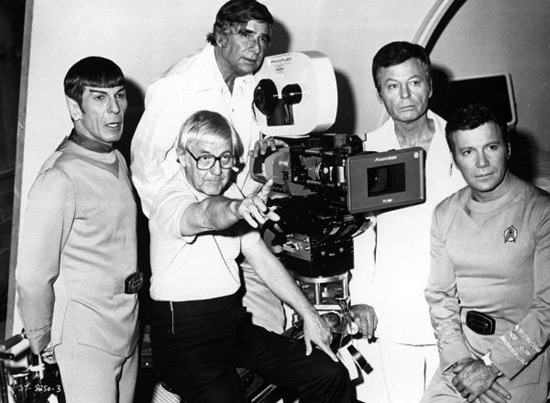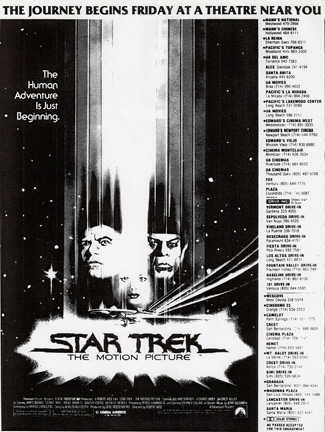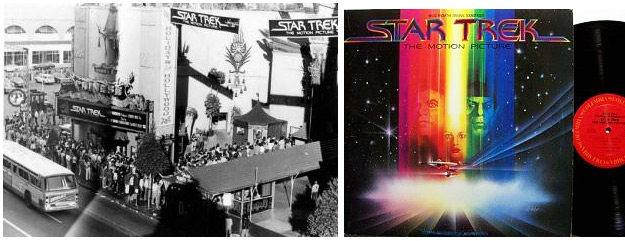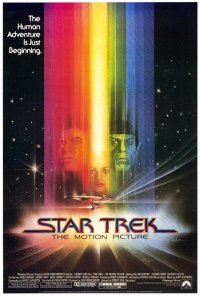Coate: In what way did Star Trek: The Motion Picture influence your desire to work in the film industry?
Altman: While it was really seeing North by Northwest in a revival house in the 70s that originally sparked my passion for movies and moviemaking, there’s no question that Star Trek: The Motion Picture dramatically fanned the flames of my love for Star Trek. I’m not sure the white hot embers of my affection for Roddenberry’s singular creation could have remained lit for another 35 years had the movie series not existed after the sacred 79 to keep it alive and vibrant. But aside from the obvious ten ton gorilla of Star Wars, which I will always love and adore, there are the many misfires of the 70s that I am still equally passionate about that would have never survived the vitriol of the Internet at the time had it existed; films like The Boys From Brazil, Logan’s Run and even The Black Hole, which all helped inspire me to make my mashed potato mountains and drive me obsessively to the Devil’s Tower that is Hollywood. And, of course, Colossus and Westworld and even Futureworld. While ST:TMP may not be my favorite Star Trek film, it probably remains the one I watch the most on DVD and Blu-ray. Part of that is nostalgia, but part is also because there’s so many great moments in the film, even if they don’t all come together cohesively. For instance, we’ve seen the scene ad nauseum where McCoy berates Kirk in private, but there’s probably not a better version of this scene than when McCoy lays into Kirk after Kirk confronts Decker. And when McCoy exits, leaving Shatner fuming as a transparent door slides closed in front of him, it’s a wonderfully quiet moment that captures everything I love about Star Trek. That said, I spent many years writing about Star Trek as a journalist and much like Michael Corleone, I am again now getting dragged back in and certainly ST:TMP very much was at the root of inspiring me to write about Trek. And without this being a shameless plug for my upcoming book, The Fifty Year Mission, I can tell you the ST:TMP chapter is perhaps one of the most interesting chapters in the book along with the one on Enterprise.

Bond: Well in my case it just reinforced my growing obsession with Jerry Goldsmith’s work—I was buying my first LPs of his music back then and TMP was certainly the cornerstone of that, and I would eventually write about film music and be lucky enough to work on many soundtrack albums and almost all the later releases of Star Trek music including a tremendous 3-disc set of all the music from TMP among other things.
Bulk: Star Trek: The Motion Picture was my first exposure to Jerry Goldsmith. My father bought the soundtrack album for me on January 1, 1980. It wasn’t the first record I owned, but it was probably the first soundtrack I owned. At the time, Klingon Battle scared me as it played on my Fisher-Price record player. And although it frightened me (even the aliens on the record sleeve were scary) I played that record to death! This was also the era of the return of the symphonic score (usually attributed to John Williams). I grew up with the genre films and their music during this period, but it was TMP that ignited my love of music for film. This is what got me interested in pursuing sound editing, which led to my work on restoring classic scores for the specialty labels (Film Score Monthly, La-La Land Records, Intrada, Kritzerland and Varese Sarabande, for instance). Now I’m thrilled to have the opportunity to work in an area I grew up loving. One of my first projects was the release of the expanded Star Trek II album. This opened the gates and led to a variety of Star Trek album releases. I’ve been fortunate to work on many of them, including La-La Land’s release of Star Trek: The Motion Picture. And to bring things full circle, I sat in on the multi-track stereo remix for Klingon Battle while that album was in production. It doesn’t scare me as much anymore.
 Burnett: My desire to make films began when I was five and saw George Pal’s production of War of the Worlds. Soon after came a chance viewing of Planet of the Apes. Then, every Sunday afternoon, I’d watch Sci-Fi Theater and see Japanese Sci-Fi like Rodan, The Mysterians and The Green Slime or fantasy epics like Jason and the Argonauts, other George Pal classics like When Worlds Collide or maybe a British film, such as a Quatermass and the Pit. The Outer Limits, UFO, Space: 1999 and especially The Twilight Zone were on television, along with endless TOS reruns. Jaws and Logan’s Run blew me away in the movie theater. Star Wars and Close Encounters were my speed of light, changing my universe and showing me new, limitless possibilities of the power of motion pictures. In the wake of those two films, I joined the Science Fiction Book Club and began to read the classics, like Foundation, Dune and Stranger in a Strange Land, opening my mind further still. Starlog, Cinemagic, Fangoria and Cinefantastique magazines fueled my thirst for knowledge about upcoming films, and then the first issue of Cinefex, with a TMP cover story and Alien follow up made me realize all I wanted to do was make movies. In 1980, the home video revolution turned me into a film scholar, and a flood of genre films in the early eighties, with all of their own wonders, filled me with hope and dreams of the industry. Believe me... it was a perfect time to be a kid, because everything you saw had never been seen before.
Burnett: My desire to make films began when I was five and saw George Pal’s production of War of the Worlds. Soon after came a chance viewing of Planet of the Apes. Then, every Sunday afternoon, I’d watch Sci-Fi Theater and see Japanese Sci-Fi like Rodan, The Mysterians and The Green Slime or fantasy epics like Jason and the Argonauts, other George Pal classics like When Worlds Collide or maybe a British film, such as a Quatermass and the Pit. The Outer Limits, UFO, Space: 1999 and especially The Twilight Zone were on television, along with endless TOS reruns. Jaws and Logan’s Run blew me away in the movie theater. Star Wars and Close Encounters were my speed of light, changing my universe and showing me new, limitless possibilities of the power of motion pictures. In the wake of those two films, I joined the Science Fiction Book Club and began to read the classics, like Foundation, Dune and Stranger in a Strange Land, opening my mind further still. Starlog, Cinemagic, Fangoria and Cinefantastique magazines fueled my thirst for knowledge about upcoming films, and then the first issue of Cinefex, with a TMP cover story and Alien follow up made me realize all I wanted to do was make movies. In 1980, the home video revolution turned me into a film scholar, and a flood of genre films in the early eighties, with all of their own wonders, filled me with hope and dreams of the industry. Believe me... it was a perfect time to be a kid, because everything you saw had never been seen before.
Dochterman: TMP was the last straw on the camel’s back… the final nail in the coffin of my aspirations… the last lemon of the jackpot. Seriously, the onslaught of Star Wars, Close Encounters of the Third Kind, and Superman: The Movie did their best to determine my obsession with movies… and Star Trek: The Motion Picture finished the job. I was enthralled not only with the story and the effects of the movie… but also with the processes and people who made it happen. I learned all I could about it at the time… and remembered and had the opportunity to meet and work with many of the creative artists that were responsible… and twenty years later, to get the chance to work with Robert Wise himself on the realization of his 2001 Director’s Edition of the film.
Fein: As a kid I was enchanted by science fiction stories. Every night I would rush home by 6pm to sit in front of my 19” color television to watch Star Trek reruns. Very often the networks would also show a classic movie in the afternoon before the show. Countless movie marathons would be scheduled each week… Science Fiction-week, Planet of the Apes-week, Abbott and Costello-week, Sinbad-week, etc. There would also be the late-night airings of Space: 1999, The Twilight Zone, and Lost in Space. I was captivated by the adventures and innovation of science fiction. It wasn’t until 1977 that Star Wars ignited my desire to become a filmmaker. I was completely drawn into that fantasy and I felt such great joy when the rebels destroyed the Death Star. So, of course, I was more than excited when I heard that Star Trek: The Motion Picture was coming. The combination of the two movie masterpieces launched my insatiable need to learn everything I possibly could about the art of filmmaking, the production process, and especially special effects. (Not unlike V’Ger’s own insatiable need to learn?) Uniquely, it was Cinefex magazine that became my bible. I wanted and read every book and magazine about the magic behind-the-scenes, and studied every movie and filmmaking documentary I could get my hands on. Filmmaking became my passion; it was in my blood. So I’d say that classic Star Trek was the spark that ignited my passion for science fiction, and The Motion Picture (and Star Wars) inspired me to make production my goal in life.
Mantz: Star Trek changed my life. I know, a lot of people say that, but for me, it really did…. If it wasn’t for Star Trek, I never would have gone to the conventions. I went to my first Trek convention on November 21, 1980 (my 12th birthday), and Walter Koenig was the guest of honor. I went to conventions pretty regularly, until I graduated from high school in 1986, went away to college and “got a life.” (In other words, I discovered girls!)…. But a year after I graduated from Penn State in 1990 with a degree in accounting, I was miserable, working a job I hated in Philly. That’s when I reached out to Creation Entertainment (the company that ran the Trek conventions), and they hired me as their controller. They moved me to Los Angeles in 1991, and I worked there for 9 years. I left there in 2000 to become a producer and film critic for Access Hollywood, and I’ve been there ever since…. So Trek gave me some direction, steering me towards an area of the business that’s been very good to me. So without Star Trek, I never would have moved to LA, where I’ve been very successful and met my wife. You can’t change your life any more than that.
Matessino: My desire to work in the film industry was motivated by films of all genres. It’s all about telling a good story and using all the tools that cinema offers to create a memorable experience for an audience. To me it feels like more of a coincidence that I happened to be a kid when Star Wars sparked a resurgence of fantasy, effects-laden movies and television. What that did was demonstrate that there was no limit to what you could put up on the screen. If you could think it up, then it was simply a matter of figuring out how (and finding the right people) to do it. As a result we started to have more access to information about how movies were made, and that in turn helped young people believe that they could do it too. Honestly, I think my own interest in cinema would have been there regardless, but I do feel very lucky to have been a kid while this amazing renaissance of fantasy filmmaking was going on…. Star Wars, then Close Encounters, then Superman, then Alien, then Star Trek: The Motion Picture… at least in terms of going to the movies, those are two-and-a-half years I wish I could experience again. It was a truly magical time.
D. Okuda: I had heard from a friend that there was an open casting call for extras in the Rec Deck scene. Naturally, I tried out and was thrilled to be picked, not just as an Enterprise crew member, but I got to be a Vulcan! I’m just a few pixels on the screen, but it really was the thrill of a lifetime. Even now, I look back and smile. I still have my Vulcan ears, somewhere!
 M. Okuda: I was lucky enough to tour the set when Star Trek: TMP was in production. I’d done a bit of work in local television and theater, so I was in awe of the scale and the quality of what was being done at Paramount. But the other thing was that while I was blown away by the amazing work on those sets, seeing the stages in person helped me realize that all of this was being done by real people, doing understandable things. I think that helped inspire me, a few years later, to send in my resume and portfolio to Paramount for Star Trek.
M. Okuda: I was lucky enough to tour the set when Star Trek: TMP was in production. I’d done a bit of work in local television and theater, so I was in awe of the scale and the quality of what was being done at Paramount. But the other thing was that while I was blown away by the amazing work on those sets, seeing the stages in person helped me realize that all of this was being done by real people, doing understandable things. I think that helped inspire me, a few years later, to send in my resume and portfolio to Paramount for Star Trek.
Coate: What are the attributes of Star Trek: The Motion Picture? What are some of its flaws or disappointing elements?
Altman: For me, the biggest problem with Star Trek: The Motion Picture is they made a release date and not a movie. Had Robert Wise had six more months to edit the film and refine it, there could have been a mini-masterpiece there. After all, this is the guy who cut Citizen Kane. To have a film that was literally finished a few days before it was screened at its Washington, DC premiere with Wise literally hand carrying the prints to the theater is not the best way to make a film, and this is in the days where effects and color timing were done on film, not in computers and prints had to be made at great cost and time. Although you can probably trace the root of the film’s failings to a much earlier time and date. When the studio decided to abandon Phase II and capitalize on the success of Star Wars by expediting production on a Star Trek film, something they had tried and failed to develop for years prior, they chose to expand the pilot script for Phase II into a movie rather than start from scratch. And, in fact, that script was nothing more than a proposed script for an episode of Genesis II, another Roddenberry pilot that never went to series. After all, Gene Roddenberry was the greenest writer that ever existed, he never missed an opportunity to recycle a script idea he came up with that had gone unused. So the film began with an idea that was a warmed-over television episode, which was already fairly redolent of a pretty decent Star Trek episode. Not the stuff of which dreams are made of. In order to get the film to the stage as quick as possible, Paramount kept the TV series producer, Harold Livingston, onboard as the writer, a man who admittedly knew next to nothing about Star Trek and was constantly being re-written by Roddenberry who knew next to nothing about movies as he had proved by a succession of ill-conceived pitches for Star Trek films that Paramount had wisely passed on previously. Clearly, no one had ever seen Pretty Maids All in a Row when they decided that Roddenberry was the right man to write and produce a Star Trek film. Fortunately, both Robert Wise and Douglas Trumbull both had a vision for the film, which helped elevate the material beyond its humble origins. (And, by the way, if you haven’t seen Pretty Maids All in a Row, you owe it to yourself to watch it. It stars Rock Hudson as a high school football coach who is seducing all the female students and cheerleaders and may very well be a murderer. When students start turning up dead, Trelane and Scotty are sent to investigate, I mean, William Campbell and Jimmy Doohan. Priceless.) I would also say for a film that’s been deemed humorless, there are some very funny moments in the movie including McCoy’s arrival as well as the scene in the observation lounge in which Kirk entreats Spock to sit down and McCoy says, “lucky for you, we just happened to be going your way” as well as Kirk’s sparring with Decker, in an underwritten role. The film is joyful and full of life through the arrival of Spock as it gets the proverbial band back together. But once the Enterprise arrives at V’Ger, the film starts to become more of a slog. That said, dismissing the familiar refrains, take another look at the brilliant production design of the V’Ger set and even Robert Fletcher’s underrated costumes, not to mention Spock’s spacewalk, which is 2001-esque in its visual poetry.
Bond: It probably boasts the most beautiful-looking starship put on film in the “refit” Enterprise, and one of the most original “alien” vessels/entities in V’Ger as visualized by Syd Mead, Doug Trumbull and the other great artists and technicians that worked on the movie. It has one of the all-time great film scores. To me the flaws outweigh the attributes in terms of a total viewing experience—it is tough for me, a rabid fan, to get through the film and I would imagine it would be torture for a novice viewer due to its pacing and the way the characters from the show are, I think, hamstrung in terms of their involvement in the story. It is certainly an important and arguably moving story for Spock; one of the most important in the series, but I don’t think they found a way to get that across to the audience as effectively as a story like Amok Time for example, which I still find incredibly involving and moving after dozens of viewings. Robert Wise directed two of my all-time favorite sci-fi films, two films I think are legitimately great: The Day the Earth Stood Still, which really laid some groundwork for Star Trek in the way it uses an alien being to comment on humanity, and The Andromeda Strain, which is one of the most absorbing movies ever made about such technical subject matter. You can see Wise using the same kind of technique in TMP, and I have no doubt he could have made a great movie of that if he’d just had a better script to work with.
Bulk: Star Trek: The Motion Picture is probably the purest form of Star Trek, as Gene Roddenberry envisioned it. It’s not difficult to see the parallels between this and The Cage (Star Trek’s first pilot) and the first season of Star Trek: The Next Generation. These are all projects where his views of the future were relatively unchallenged…. Perhaps people don’t like the story, but as mentioned before, it is pure Star Trek writ large and best appreciated on the biggest screen with the loudest sound system. Robert Wise and all of the filmmakers took The Motion Picture title seriously, so this is a movie designed to be enjoyed in a large environment. Viewing the six-minute “Enterprise” sequence on a television with an inadequate sound system will diminish the impact and perhaps seem “dull” (to quote Mad Magazine’s parody)…. Many of the complaints about the movie deal with the pace or the story. I don’t agree with these views, but to give you an idea, some alternate titles are Where Nomad Had Gone Before (a reference to the original series episode, The Changeling, dealing with a robot searching for its creator), The Motion-less Picture and The Motion Sickness. As has been well documented (most recently by Preston Neal Jones in the new book Return to Tomorrow), TMP was an ambitious film locked into a specific release date and there was never time to preview it. That’s more of a disappointment with the filmmaking process than the actual film. That we’re talking about the movie 35 years later shows that it turned out okay.

Burnett: That TMP didn’t “feel” like an original series episode is both the film’s greatest strength and greatest weakness. On one hand, the production team really did create a vision which felt absolutely cinematic and quite unlike anything audiences had seen before, especially as far as Trek was concerned. There’s a sweeping scope to both the production and the story seldom seen in cinematic science fiction either before or since. But the serious tone, the deliberate pacing and the very intellectual conceits of the storyline were not satisfying for much of the audience, who expected Gorns, English-speaking Klingons, Tribbles, and even talking computers with more scintillating personalities. Entirely bereft of the perceived breezy, pulpy fun and humor of certain episodes of Trek, the mass audience and much of the fan base were expecting something more along the lines of Star Wars or Superman: The Movie. Additionally, Kirk, Spock and McCoy, in an absolutely audacious choice, were deeply unhappy people when the film began. All were varying degrees of morose, angry and actually depressed states in which we’d certainly never seen these characters before, further detracting from a positive experience for the audiences. But for discerning audiences with open minds, TMP provided a unique experience, leaving some audience members, myself included, elated at the prospect, “The Human Adventure Is Just Beginning.”




